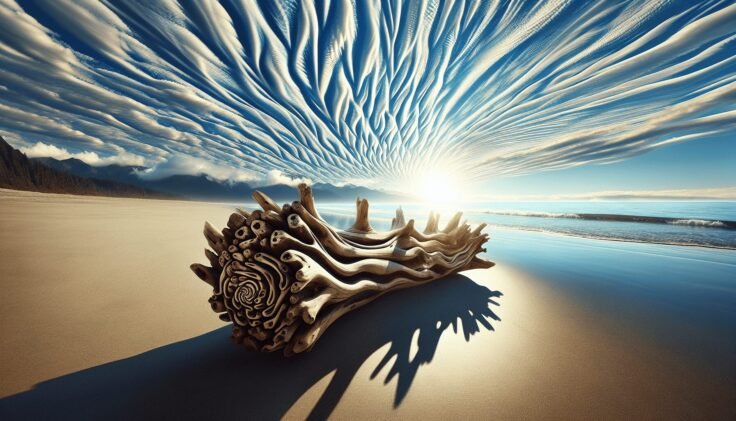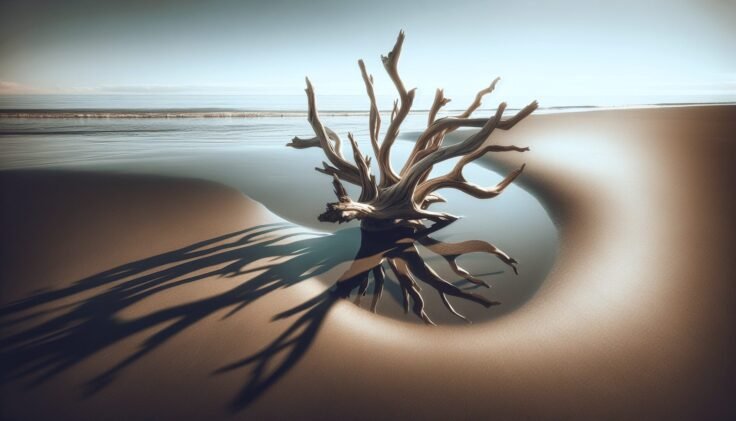Do you remember the last time you stood on a beach and noticed the smooth, weathered pieces of driftwood scattered along the shore? These unique pieces of nature’s artistry often evoke a sense of wonder and the urge to create something beautiful. If you’ve ever thought about incorporating these natural treasures into your artistic endeavors, driftwood drawing might just be the perfect creative outlet for you. This guide will walk you through the intricate art of using driftwood as a medium and inspiration for drawing.

Understanding Driftwood
What is Driftwood?
Driftwood refers to any wood that has been washed onto a shore or beach by the action of winds, tides, waves, or man. It’s essentially nature’s way of recycling trees, branches, and wood debris that end up in waterways. Over time, the water smoothens and shapes these pieces, making each piece unique with its patterns, textures, and sizes. This natural weathering process makes driftwood a fascinating subject and tool for artistic exploration.
The Appeal of Driftwood
One of the most appealing aspects of driftwood is its ragged yet smooth texture. Each piece tells a story, carved out through the movement of water and time. Artists are drawn to driftwood for its varied forms and natural beauty. It offers an opportunity to create artworks that connect with nature and tell stories of environmental influences. Artists can use driftwood in countless ways, from drawing inspiration to creating stunning pieces of artwork.
Locating and Collecting Driftwood
Finding driftwood can be an adventure in itself. Coastal areas, lakeshores, and riverbanks are the best places to look. When collecting driftwood, always ensure that you are respectful of the environment and any local regulations regarding the gathering of natural materials. It is essential to take only what you need and to consider the ecological impact of removing wood from its natural habitat.
Preparation and Tools
Cleaning Your Driftwood
Once you have collected pieces of driftwood, cleaning is the next important step. It is vital for both aesthetic and practical purposes. Begin by gently brushing off dirt and sand. If pieces are significantly grimy, consider soaking them in a mild bleach solution to eliminate any remaining bacteria or salt deposits, followed by rinsing. Allow ample drying time, as the wood needs to be completely dry to be workable.
Essential Tools for Drawing
When embarking on driftwood drawing, a few essential tools are necessary:
- Pencils: A range of graphite pencils, from hard (H) to soft (B), will give you flexibility in shading and line work.
- Erasers: A kneaded eraser and a precision eraser can help in highlighting details and correcting mistakes.
- Paper: Quality drawing paper that can handle different pressures, erasing, and perhaps some light washes.
- Fineliner Pens: For more defined lines and details, especially if you wish to add ink to your drawings.
Optional Tools
Although not essential, there are some optional tools that can enhance your driftwood drawing experience:
- Colored Pencils or Watercolors: To add color to your work subtly.
- Blending Stumps: Useful for smoothing out pencil or charcoal markings for a softer effect.
- Fixative Spray: To preserve your finalized art piece.
Drawing Inspiration
Observing Driftwood Characteristics
Before starting any drawing, take time to observe the unique features of your driftwood. Look closely at its form, grain, texture, and the patterns created by its history with water. Each piece may suggest several interpretations or stories. The more you observe, the richer your artistic narrative will be.
Sketching Initial Ideas
Start by creating quick, loose sketches of your driftwood. This stage is about capturing basic shapes and forms. Don’t concern yourself with details yet. Sketching multiple angles and perspectives allows you to explore different artistic directions and helps refine your vision.
Exploring Themes and Subjects
Consider what themes or subjects you’d like to explore through your driftwood drawing. Driftwood can symbolize various concepts like resilience, transience, or the power of nature. It can also serve as a backdrop or a canvas for drawing other subjects such as birds, sea life, or abstract designs interwoven with the wood’s patterns.
Techniques in Driftwood Drawing
Emphasizing Texture
Texture adds depth and interest to drawings. Driftwood’s weathered surface is perfect for practicing texture rendering. Use a combination of hatching and cross-hatching techniques to depict the roughness or smoothness of the wood. Experiment with different pencil grades to bring out unique textures.
Playing with Shadows and Light
Lighting can dramatically alter the appearance of your driftwood drawing. By understanding light and shadow, you can create a three-dimensional effect. Use softer pencils to shade areas where the light is less intense and harder pencils for highlights.
Incorporating Other Elements
Consider integrating elements like foliage, waves, or shells into your drawing. This can provide context and create a narrative. Mixing organic elements with your primary focus of driftwood can add depth and intrigue to your art piece.

Tips for Enhancing Your Driftwood Drawings
Experimentation
Don’t be afraid to experiment with different styles and techniques. Driftwood, as a subject, can cater to a minimalist approach as well as detailed realism. Each style brings out a different aspect of its beauty.
Practicing Regularly
Like any form of art, regular practice is key to improvement. Spend time working on your driftwood drawings consistently. This will not only improve your skills but also deepen your appreciation for the subject matter.
Gaining Feedback and Inspiration
Share your drawings with others and seek feedback. This can provide fresh perspectives and inspire you further. Engaging with a community of artists or attending workshops can broaden your horizons and offer new ideas.
Conclusion
Driftwood drawing is more than an artistic endeavor—it’s a journey into nature’s stories, offering endless inspiration and the chance to connect with the natural world. The unique textures, forms, and history encapsulated in each piece of driftwood provide a rich canvas for creativity. Whether you choose to use driftwood as a subject, a tool, or an inspiration, the possibilities are as boundless as the shorelines it originates from. Embark on this artistic voyage with confidence, knowing that every piece of driftwood holds a tale waiting to be told through your drawings.